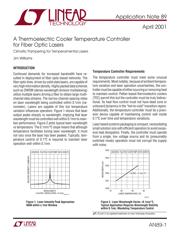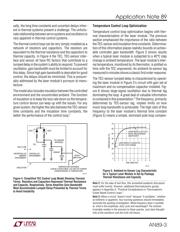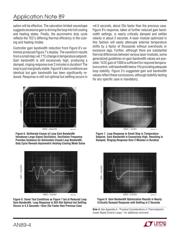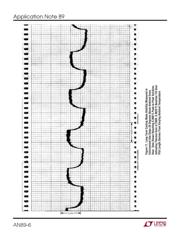herunterladen

Application Note 89
AN89-1
A Thermoelectric Cooler Temperature Controller
for Fiber Optic Lasers
Climatic Pampering for Temperamental Lasers
Jim Williams
April 2001
, LTC and LT are registered trademarks of Linear Technology Corporation.
INTRODUCTION
Continued demands for increased bandwidth have re-
sulted in deployment of fiber optic-based networks. The
fiber optic lines, driven by solid state lasers, are capable of
very high information density. Highly packed data schemes
such as DWDM (dense wavelength division multiplexing)
utilize multiple lasers driving a fiber to obtain large multi-
channel data streams. The narrow channel spacing relies
on laser wavelength being controlled within 0.1nm (na-
nometer). Lasers are capable of this but temperature
variation influences operation. Figure 1 shows that laser
output peaks sharply vs wavelength, implying that laser
wavelength must be controlled well within 0.1nm to main-
tain performance. Figure 2 plots typical laser wavelength
vs temperature. The 0.1nm/°C slope means that although
temperature facilitates tuning laser wavelength, it must
not vary once the laser has been peaked. Typically, tem-
perature control of 0.1°C is required to maintain laser
operation well within 0.1nm.
Temperature Controller Requirements
The temperature controller must meet some unusual
requirements. Most notably, because of ambient tempera-
ture variation and laser operation uncertainties, the con-
troller must be capable of either sourcing or removing heat
to maintain control. Peltier-based thermoelectric coolers
(TEC) permit this but the controller must be truly bidirec-
tional. Its heat flow control must not have dead zone or
untoward dynamics in the “hot-to-cold” transition region.
Additionally, the temperature controller must be a preci-
sion device capable of maintaining control well inside
0.1°C over time and temperature variations.
Laser based systems packaging is compact, necessitating
small solution size with efficient operation to avoid exces-
sive heat dissipation. Finally, the controller must operate
from a single, low voltage source and its (presumably
switched mode) operation must not corrupt the supply
with noise.
WAVELENGTH
(1nm/DIV, RESOLUTION = 0.1nm)
RELATIVE INTENSITY (10dB/DIV)
AN89 F01
(SOURCE: FUJITSU FLD5F10NP DATA SHEET)
LASER TEMPERATURE (°C)
10 20 30 40
WAVELENGTH (nm)
AN89 F02
1555
1554
1553
1552
1551
1550
SLOPE = 0.1nm/°C
(SOURCE: FUJITSU FLD5F10NP DATA SHEET)
Figure 1. Laser Intensity Peak Approaches
40dB within a 1nm Window
Figure 2. Laser Wavelength Varies ≈0.1nm/°C.
Typical Application Requires Wavelength Stability
within 0.1nm, Mandating Temperature Control
Verzeichnis








